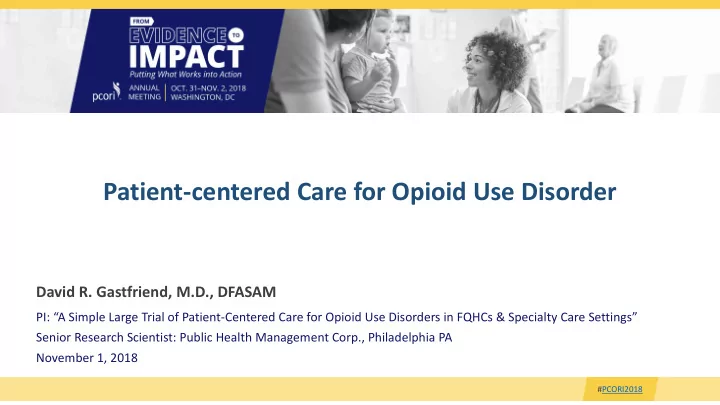

Patient-centered Care for Opioid Use Disorder David R. Gastfriend, M.D., DFASAM PI: “A Simple Large Trial of Patient-Centered Care for Opioid Use Disorders in FQHCs & Specialty Care Settings” Senior Research Scientist: Public Health Management Corp., Philadelphia PA November 1, 2018 #PCORI2018
David Gastfriend, MD, DFASAM Disclosures Rela latio ionship ip Company ny(ies es) Speakers Bureau blank Advisory Committee blank Consultancy BioCorRx, Horizon BCBS of NJ, IBM Watson Review Panel blank Board Membership blank Honorarium blank Ownership Interests Alkermes Inc., Am. Soc. of Addiction Medicine, DynamiCare Health Inc., Intent Solutions Inc. 2 • November 28, 2018
Objectives At the conclusion of this activity, participants should be able to • Describe evidence-based treatments for Opioid Use Disorder (OUD) • Describe current practices for OUD treatment • Describe challenges regarding patient access to treatment 3 • November 28, 2018
Current & Emerging Practice for Opioid Use Disorder • Current Practice : Specialty counseling and detox • Office-based opioid treatment (OBOT) is rising • Abstinence Model is dominant model • Motivational Enhancement Therapy growing • American Society of Addiction Medicine (ASAM) Criteria • Six dimensions of assessment and treatment: Withdrawal, Biomedical, Psychological, Readiness, Relapse Potential, Environmental • Use the least intensive resource(s) known to yield optimal outcomes • Personalized Addiction Treatment-to-Health Model (PATH) Study • Randomized control trial (N=800) • Compares PATH to community standard (specialty addiction programs) 4 • November 28, 2018
Evidence-based Treatments for Opioid Use Disorder Agent • Medication-assisted treatment (MAT) • Agonists: Methadone • Partial agonists: Buprenorphine SL/XR • Antagonists: Naltrexone PO/XR Host • Contingency management (CM) • Cognitive behavioral therapy (CBT) • Peer support Environment 5 • November 28, 2018
Challenges & Solutions for Opioid Use Disorder Challenges Primary MAT Care • 90% do not seek or receive care • Limited resources and access CBT Behav’l CM • Impaired motivation Health • Stigma C • Highly fragmented system Psych Peer Support M Care Proposed Solution: PATH in Federally Qualified Health Centers (FQHCs) • Multidimensional assessment • Evidence-based treatment: MAT, CBT, CM, peer support and collaborative care 6 • November 28, 2018
Patient Need & Patient Choice Issues Marked Heterogeneity in the Patient Population Due to • Opioid type (i.e.: prescription, heroin, or fentanyl) • Route of administration • Age, chronicity, and level of function • Prior treatment experience and phase of recovery • Chronic pain or pain orientation • Co-occurring disorders • Social chaos or disenfranchisement • Discontinuation concerns 7 • November 28, 2018
Patient Need & Patient Choice Issues, continued • MAT selection • No predictors yet identified for extended-release naltrexone (XR-NTX) selection (except need for detox) • The best basis for methadone vs. buprenorphine vs. XR-NTX treatment may be patient preference • More evidence needed for initiation and termination decisions • Psychosocial services • Recovery Model vs. Harm Reduction? • Scheduled vs. flexible approaches? • Best basis may be patient preference 8 • November 28, 2018
PATH Pilot Study: Six Implementation Findings • In medication-assisted treatment , • Most buprenorphine-waivered prescribers don’t prescribe • XR-NTX induction is limited • Group therapy and peer specialists need reimbursement • Contingency management faces policy obstacles, but solutions exist • Primary care has brief behavioral focus, but needs a longitudinal focus • There is a need more for addiction knowledge , resources are welcome • Peer-mediated street recruitment can be very successful 9 • November 28, 2018
Opportunity for Impact • U.S. has 1,367 FQHCs • Reach more than 10,000 communities • Serve more than 25 million people (or ~1 in 12 Americans) • If PATH shows similar or better retention/abstinence to usual care, then dissemination of this successful, feasible model of care could substantially improve access and outcomes in the epidemic 10 • November 28, 2018
Learn More • www.pcori.org • info@pcori.org • #PCORI2018 • https/e mpower.Stanford.edu 11 • November 28, 2018
Thank You! David R. Gastfriend, M.D., DFASAM PI: “A Simple Large Trial of Patient-Centered Care for Opioid Use Disorders in FQHCs & Specialty Care Settings” Senior Research Scientist: Public Health Management Corp., Philadelphia PA November 1, 2018 12 • November 28, 2018
Recommend
More recommend